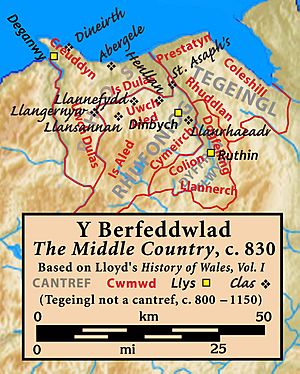Tegeingl facts for kids
Tegeingl, also known as Englefield, was an important region in northeast Wales during the Middle Ages. It was like a small county, called a cantref, back then. In the 1200s, King Edward I of England took control of northern Wales. After this, Tegeingl became part of a larger area known as Flintshire.
Contents
Where Did the Name Tegeingl Come From?
The name Tegeingl has a long history! It came from an ancient group of people called the Deceangli. They were a Celtic tribe who lived in this area during the Iron Age, even before the time of Christ, around 100 BC.
Where Was Tegeingl Located?
Tegeingl was on the northern coast of Wales. It was the eastern part of a larger region called Perfeddwlad. This area stretched between the River Clwyd and the Deeside. Today, the land that was once Tegeingl is mostly the same as the modern county of Flintshire.
A Look Back: The History of Tegeingl
Tegeingl was made up of three smaller areas called commotes: Rhuddlan, Prestatyn, and Coleshill (also known as Cwnsyllt).
Early Control of Tegeingl
Originally, Tegeingl was part of the Kingdom of Gwynedd, a powerful Welsh kingdom. But in the late 700s, an Anglo-Saxon kingdom called Mercia conquered it. Mercia (which was English) controlled Tegeingl for more than 300 years!
Welsh Rule Returns
In the 1100s, a Welsh prince named Dafydd ab Owain Gwynedd took Tegeingl back for Wales. Around the same time, a man named Edwin of Tegeingl (who died in 1073) was known as the "lord" or "prince" of Tegeingl.
His son, Owain, became the next lord. Owain even helped the Anglo-Normans when they invaded North Wales in the 1090s. Owain's family stayed powerful in North Wales for a while. However, in 1125, Owain's sons were killed by a son of Gruffudd ap Cynan, who was the Prince of Gwynedd.
Changing Hands and Final Conquest
After this, Tegeingl was often fought over. It changed hands many times between England and Gwynedd. But eventually, King Edward I of England took full control. This happened during his big conquest of the Principality of Wales between 1277 and 1283.
After the conquest, Tegeingl was officially made part of Flintshire. This was done through a law called the Statute of Rhuddlan.


